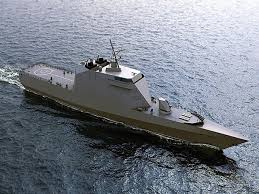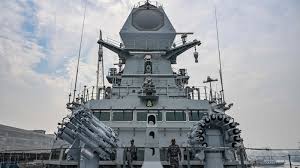
STEALTH WARSHIP
INTRODUCTION:
A stealth ship is a ship that employs stealth technology construction techniques in an effort to make it harder to detect by one or more of radar, visual, sonar, and infrared methods.
These techniques borrow from stealth aircraft technology, although some aspects such as wake and acoustic signature reduction (acoustic quieting) are unique to stealth ships’ design. Although radar cross-section (RCS) reduction is a fairly new concept, many other forms of masking a ship have existed for centuries or even millennia.

WORKING OF STEALTH WARSHIPS:
A stealth warship is designed to reduce its visibility to enemy radar, infrared sensors, and other detection methods, allowing it to operate more covertly. Here’s how it works:
- Radar Cross-Section (RCS) Reduction:
- Shape and Design: Stealth warships often have angular, flat surfaces or slanted surfaces to deflect radar waves away from the source. This minimizes the radar cross-section (RCS), making the ship harder to detect.
- Radar-Absorbing Materials (RAM): These ships are coated with special materials that absorb radar waves, rather than reflecting them, further reducing the RCS.
- Infrared Signature Minimization:
- Engine Heat Management: Stealth warships are designed to minimize heat emissions from engines and exhaust systems, which are often detected by infrared sensors. This is achieved by using advanced cooling systems or diverting exhaust gases away from the ship’s main heat signature.
- Special Coatings: The use of materials and paints that reduce the infrared signature helps in concealing the ship’s heat from infrared tracking systems.
- Acoustic Signature Reduction:
- Quiet Propulsion: Stealth warships often employ quieter propulsion systems to reduce the amount of noise emitted into the water. This makes it harder for enemy sonar systems to detect the ship.
- Hull Design: The hull is designed to minimize cavitation (bubbles or noise created by the ship’s movement), helping to further reduce acoustic detection.
TECHNOLOGIES USED IN STEALTH WARSHIP:
Radar Absorbent Materials (RAM)
- These materials are designed to absorb radar waves rather than reflect them, reducing the ship’s radar cross-section (RCS). RAM coatings and composites are applied to the ship’s exterior to effectively lower its detectability by radar systems.
2. Advanced Hull Shape and Design
- The hulls of stealth warships are typically designed with angular, faceted surfaces that deflect radar waves away from their source, preventing clear radar returns. This design minimizes the ship’s visibility to radar and makes it appear smaller or invisible.
3. Stealth Coatings and Paints
- Special coatings or paints are applied to the ship’s surface to absorb or scatter electromagnetic waves, further reducing its RCS. These coatings can also have infrared-absorbing properties to reduce thermal signatures.
4. Cloaking and Signature Management Systems
- Infrared Signature Reduction: Stealth warships incorporate systems that control or conceal heat emissions from the engine and other heat-producing components. For example, using advanced cooling systems and heat shields diverts or dissipates heat more effectively, preventing the ship from being detected by infrared sensors.
- Exhaust Management: Exhaust systems are designed to reduce heat signatures or direct them away from likely detection points, such as the ship’s rear or exhaust vents.
ADVANTAGES:
Enhanced Survivability: Stealth warships are designed to avoid detection, which significantly reduces the likelihood of being targeted by enemy radar, missiles, or other weapons. This stealth capability allows them to operate in contested environments with a higher degree of safety and effectiveness, providing an advantage in surprise attacks or covert missions.
Operational Flexibility: Because stealth warships are harder to detect, they can perform a wider range of missions, including reconnaissance, strike operations, and intelligence gathering, without revealing their position. This makes them valuable assets for naval forces, especially in hostile territories or during high-stakes operations where stealth is critical to success.
DISADVANTAGES:
High Cost: The advanced materials, design, and technologies required to reduce a warship’s radar cross-section, infrared signature, and acoustic footprint are expensive.
Limited Payload and Size: Due to the design constraints needed to maintain stealth characteristics, these warships often have reduced space for weapons, equipment, or crew. The focus on stealth can compromise certain operational capabilities, such as weapon loadout or range, making them less versatile in certain scenarios compared to non-stealth warships.

